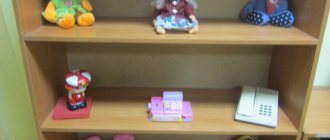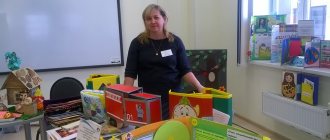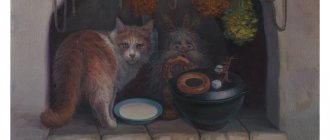What is a mobile folder?
A mobile folder is a convenient, practical information stand for children, parents and educators. Its two-sided samples contain information about two current topics at the same time. The number of sections depends on the volume of the message.
Design advantages:
- mobility;
- ease of manufacture;
- strength;
- aesthetics.
The pages of travel folders most often contain rules of behavior, advice from pediatricians, child safety issues, methodological recommendations, information about seasonal changes in nature and holiday dates.
The product is usually placed on lockers in the children's locker room, where parents can study the information while they wait for their children to change clothes for home.
Games for speech development for children 4-5 years old
Folder “Games for speech development”
The material is designed for use by parents in joint activities with children of middle preschool age (4-5 years).
These games develop speech, logical thinking, teach generalization and classification. Speech games do not require much time or special preparation. You can play word games while you are dressing your child, while walking, going to kindergarten, sitting in line for an appointment with the pediatrician, preparing dinner, or going to bed. It is impossible to overestimate the importance of speech games for a child’s development. They develop not only speech, but also thinking, imagination, reaction speed, memory and other mental processes.
Here are examples of speech games:
1. “Say the opposite.” White-...(black), light-...(dark), long-...(short), day-...(night), yesterday-...(tomorrow), warm-...(cold), etc. 2. “Who does what?” barks...(dog), moos...(cow), buzzes...(bee), etc. 3. “Who is bigger?” In turns, an adult and a child each name one item of clothing or utensils, insects or animals, fruits, vegetables, plants (flowers, trees,...), that is, any general concepts. 4. “Riddles.” We come up with riddles about different objects. First the adult comes up with the idea, the child guesses, then vice versa. For example: guards the house, bites strangers. It is not necessary that the riddle rhyme, the main thing is that it is interesting for both you and the child. 5. “Don’t say yes or no.” You take turns asking each other questions; you cannot answer with “yes” and “no.” If you said “yes” or “no”, you lost. For example: “Are you in a good mood today?”; “Are we going home after kindergarten?” 6. “What do I see?” Tell each other what you see now. For example: “I see trees covered with snow.” “And I see that a car is driving along the road.” The main thing is that the sentence contains several words, not just one. 7. “Whose mother?” You name an animal, the child must name its cub, or, conversely, you name the cub, and the child must name its mother. For example: calf, lamb, chicken, hippo, parrot, sparrow, pig, frog, ... 8. “Who lives where?” When you name an animal, the child must say where it lives. For example: shark (in the sea), pike (in the river), cow (in the barn), camel (in the desert), penguin (in Antarctica), polar bear (in the north), lion (in Africa), etc.
We recommend watching:
Speech development of preschoolers Poems for the development of speech of preschoolers Games with sand for children of senior preschool age Summary of a lesson on speech development in the second junior group on the topic: Spring
Similar articles:
Tongue twisters for the development of speech and diction in children
Pure sayings for children 3-4 years old
Outdoor games for children at holidays
Silent games for children 4-6 years old
Jokes for children 4-6 years old
How to make a sliding folder with your own hands?
A stand in the form of a mobile folder can be ordered at a special enterprise, but it is cheaper and more accessible to make it yourself.
Option #1
Required tools and materials:
- thick cardboard;
- transparent and colored tape;
- files;
- self-adhesive paper;
- stationery knife;
- scissors;
- ruler;
- stapler with metal staples;
- pencil.
Algorithm of actions:
- Free the files from the special holes by removing them with scissors.
- Cut out 8 sheets of cardboard, the perimeter of which is 0.5 cm larger than the file.
- Cover each cardboard plate with a suitable color film on both sides.
- The size of the adhesive paper on one side should be larger for the allowance on the opposite surface.
- The edges can be decorated with colored tape for strength.
- Secure the files evenly onto the prepared bases with adhesive tape of a certain color.
- The bases are attached to each other using transparent tape. The color palette of the edges can be alternated during assembly.
- Now all you have to do is insert the relevant information into the pockets - and the folder is ready.
Option No. 2
Necessary materials:
- 6 cardboard blanks measuring 28x36 cm;
- PVA glue;
- 12 pieces of wallpaper 25x32 cm;
- 11 strips of fabric 36x5 cm;
- 2 ribbons 115×5 cm.
Algorithm of actions:
- Connect the cardboard bases to each other by gluing strips of fabric to them, leaving 1 cm gaps between the surfaces for convenient folding.
- The side surfaces are covered in the same way. Allow at least 2 hours to dry. Turn the folder over and glue the connections on the opposite side. Lastly, cover the bottom and top surfaces.
- The fabric requires careful smoothing, removing wrinkles and folds. Dry for 1.5 hours.
- After processing all the side, top and bottom edges with fabric, you can apply wallpaper blanks, placing them equally on each sheet. Let dry under pressure.
- Glue the files without a white border to each page with double-sided tape, after which you can insert information into the pockets.
Option #3
Foam ceiling tiles without relief are used as a frame. The work will require a lighter, 1 knitting needle and a bright rope 3 m long.
Algorithm of actions:
- Use a knife to evenly remove the excess part of the tile, leaving a surface for placing printed information.
- Fold the warps in pairs, pierce the holes with a heated knitting needle to thread the rope.
- Connect the edges of the blanks by threading the braid crosswise. A slight tightening will ensure mobility.
- Glue the transparent pockets to the foam with double-sided tape.
Decorative stickers will add originality to any design. Instead of covers, you can use ready-made plexiglass pockets. The necessary elements, numbers, letters are cut out from colored adhesive film.
Important information is reflected in a clear and accessible form. The compact sliding folder is easy to fold and can be stored for a long time.
Materials for creating thematic folders
We suggest downloading and printing the necessary materials for creating mobile folders:
- What does a child need for kindergarten?
- Child safety
- Summer
- Hardening children in summer
- How to dress a child in summer
- Playground safety
- Little whys
- Hand hygiene
What does a child need for kindergarten?
Child safety
Summer
Hardening children in summer
How to dress a child in summer
Playground safety
Little whys
Hand hygiene
Autumn: how to keep children healthy?
Observations of changes in nature in autumn
Folder - mobile for parents “Teaching mathematics at home” (5-6 years old)
“Teaching mathematics at home” (5-6 years)
“You can only learn through fun” French novelist Anatole France.
We need to start by instilling in the child attention, the ability to compare and observe. Games help your child become more comfortable with mathematics. In the process of playing, children learn complex mathematical concepts, learn to count, read and write, and the closest people - his parents - help the child develop these skills. But it's not only a workout, it's also a great time spent with your own child. However, in the pursuit of knowledge, it is important not to overdo it. The most important thing is to instill in the child an interest in learning. To do this, classes should be held in a fun way.
The main thing when learning to count is not mastering computational skills at all, but understanding what numbers mean and what they are needed for. His knowledge will be stronger if you reinforce it at home.
Before school, it is worth teaching your child to distinguish:
-spatial arrangement of objects (above, below, right, left, under, above, etc.);
- recognize basic geometric shapes (circle, square, rectangle, triangle);
-size of objects;
- the concepts of “more”, “less”, “part”, “whole”.
Forms of teaching elementary mathematical concepts - games.
Game "On the contrary"
(thick - thin, high - short, wide - narrow).
Game "Guests have arrived"
(determining equality and inequality of two groups of objects without counting using the technique of superposition). Use the terms “more”, “less”, “equally”. Make sure that the child does not count the same item twice.
Game "Name the neighbors"
(the adult names the number, and the child names his neighbors). For example, an adult says: “Two,” and a child says: “One, three.”
And the game “Divide the object”
(cake into 2, 4, etc. parts). Show that the whole is always greater than the part.
It is advisable to limit the composition of problems to addition and subtraction in one action. Let the child take part in creating the problem himself. It is important to teach him to pose a question to a problem, to understand what kind of question can be the logical conclusion of the conditions of a given problem.
And the game “Find a pair”
(in front of the child there are number cards in a row with objects drawn or pasted on them). The adult shows the number, and the child finds the corresponding card.
Game “What number is missing?”
The missing number is called.
Account on the way.
Small children get tired very quickly in transport if they are left to their own devices. This time can be spent usefully if you count together with your child. You can count the passing trams, the number of child passengers, shops or pharmacies. You can come up with an object for everyone to count: the child counts the big houses, and you count the small ones. Who has more?










